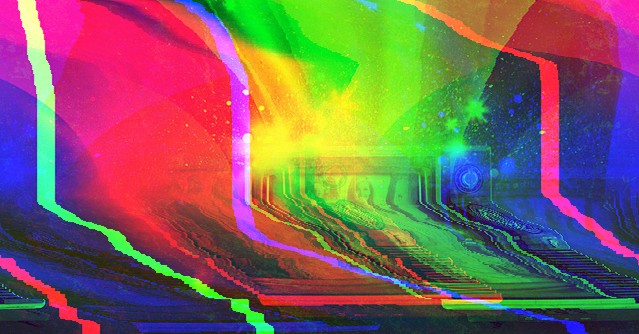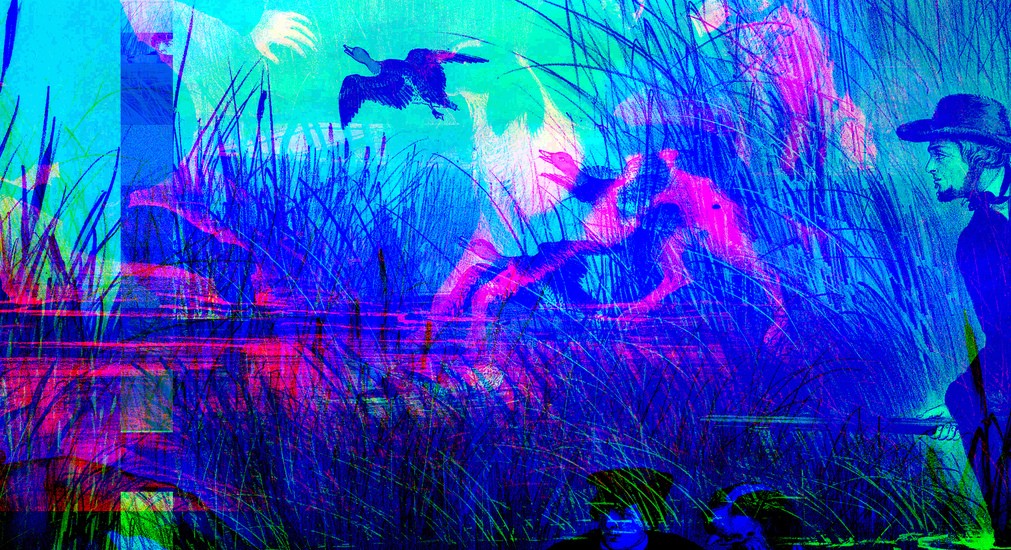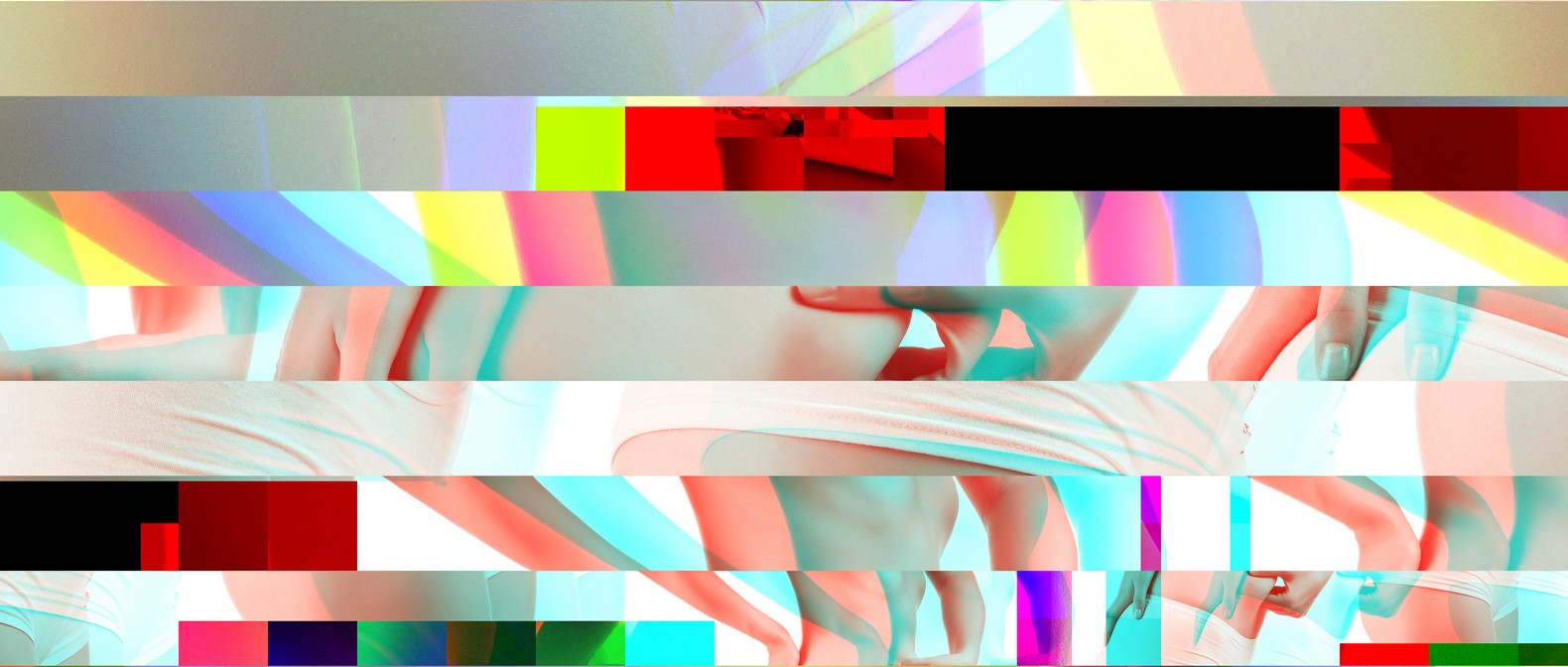algorithm executes when encoding a media file. Glitch exposes that process resulting in aesthetics reminiscent of Cubism. Cubist paintings were often 2-dimensional broken-up studies of motion, not disimilar to the relationship a codec has to a video when it breaks
down and studies motion vectors in the compression process. When these codecs are disturbed (hacked/glitched) what results can be easily formally compared to the cubist works. In this way glitch art is like Cubism. “Dada or Dadaism is a cultural movement that began in Zürich, Switzerland, during World War I”* Dada art was playful, absurdist, and often times intentionally nonsensical.
Dada art could take the form of a complex collage or a simple found object (readymade). Glitch can be instigated complexities or stumbled upon accidents. In many ways Dada was a response to the paradigm shift of the industrialized WWI.

The digital/information
revolution is (could lead to) a paradigm shift of its own – Glitch art responds to this by questioning the stability (or efforts towards an idealized stability) of such a shift. In this way glitch art is like Dadaism. “Structural-Materialist filmmakers like Hollis Frampton and Michael Snow created a highly formalist cinema that foregrounded the medium itself: the frame, projection, and
most importantly, time.”* Just like Brakhage painting colors on clear celluloid, a hacker punching 1’s and 0’s into a file to invoke broken shards of colorful pixels exposes the digital medium for what it is. In this way glitch art is like experimental film.
The art technique known as Décollage, “is the opposite of collage; instead of an image being built up of all or parts of existing images, it is created by cutting, tearing away or otherwise removing, pieces of an original image.”* This technique was often applied to
2D work but in some cases to moving image work as well, as is the case with Fluxist artist Wolf Vostell’s piece “Television Decollage.” The décollage process was one of forced entropy and decay, prompting chaotic situations and leaving the audience to piece the works back together in their minds. In this way glitch art is like Décollage. Glitch art, like Pop art, is an amorphous term – a canopy who’s tenants slip under and out of. These terms can be expanded to include much more than might immediately come to mind. This is because at their core they’re simply a loose link to a key concept: the interest in the “mistake”, the interest in “popular culture”. Pop’s link to culture is an
important one here; it critically responds to culture primarily by appropriating it. Glitch art often has similar layers of appropriation at play. The first is the same as Pop art: the content found in many glitch works are commonly borrowed from popular culture. The second layer is the appropriation of the glitch itself. Though an artist can create/instigate glitches (s)he will often intentionally/ideologically not do this. Instead choosing to search for them by exploring the digital landscape and catching them (screen grabbing,
recording, etc.) when they occur. In this way glitch art is like Pop art. Continuing with this thought, we might picture the glitch artist to be an explorer. “Exploration is the act of searching or traveling a terrain (including space) for the purpose of the discovery of resources or information.”* We are referring here primarily to physical space. “The term may also be used metaphorically, for example persons may
speak of exploring the internet, sexuality, etc. In scientific research, exploration is one of three purposes of empirical research (the other two being description and explanation).
Exploration is the attempt to develop an initial, rough understanding of some phenomenon.”* In all these ways the glitch artist is like an explorer. The comparison to land and nature reminds me of another parallel often drawn with the platypus. As the only mammal that lays eggs the platypus can be seen as nature’s mistake/accident. It is an “egg-laying, venomous, duck-billed, beaver-tailed, otterfooted mammal [which] baffled European naturalists when they first encountered it, with some considering it an elaborate fraud.”* When one naturally encounters a glitch, either on a computer or in a river, it is not uncommon to be initially “baffled”. This perplexing nature makes them difficult to comfortably classify. In this way nature is like a glitch artist. Robert Smithson was an American artist famous for his “land art.” His “earth works” often highlighted decay and the process of breaking down. One work in particular “Partially Buried Woodshed” was made, “to illustrate geological time consuming human history.”

His concern was often the entropy of systems. In this way Robert Smithson was
like a glitch artist. The role of humor in glitch art is not to be dismissed. As part of a deal with ABC Andy Kaufmen was given his own show, “Andy’s Funhouse.” The show consisted of Kaufman’s famous gags but one bit stands out, “a segment that included fake television screen static as part of the gag, which ABC executives were not comfortable with, fearing that viewers would mistake the static for broadcast problems and would change the channel – which was the comic element Kaufman wanted to present.”* The intentional television malfunction was to catch people off-guard, this element of the unexpected is key to our expiereince of a glitch. In this way Andy Kaufman is like a glitch artist.
The American artist/architect Gordon Matta-Clark was famous, “for his ‘building cuts,’ a series of works in abandoned buildings in which he variously removed sections of floors, ceilings, and walls.”* Often times this intentional break-down simply meant a removed section from a building other times it could be an entire house split in half. Matta-Clark’s work was considred “sculptural intervention” in the way glitch art can be seen as a “technological intervention.” In this way Gordon Matta-Clark was like a glitch artist.
A glitch, even when it is intentionally provoked, always maintains a level of chance, at least from a human point of view because of the computer’s seemingly random and chaotic way of breaking down. Art has a long relationship with chance, one artist that always comes to mind is John Cage. Cage was an artist of many disciplines but most prominent in the field of expiramental music and in particular chance music. Cage developed a systematized approach to composing music through chance experiments, using coins or the I-Ching. This approach of intentionally marring chance to systems is not unlike approaches developed by glitch artist. Cage was also very interested in the
role “noise” played in music and art. Often disregarded as unwanted interference by popular music noise was embraced by Cage as the key part of his aural pallet. In this way John Cage was a glitch artist.

At the digital intersection of media art and art and technology lies new media art. New media art is often conceptually inquisitive, technologically innovative, and socially/culturally critical. New media art foregrounds critical relationships to digital culture and
culture in general. As the technology is constantly changing and the platforms for new media art, like the internet, remain in flux so to will the efforts to codify them. In this was glitch art is like new media art.
